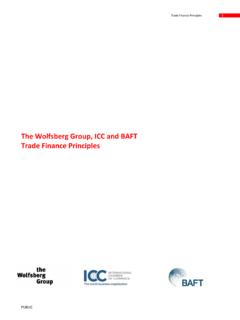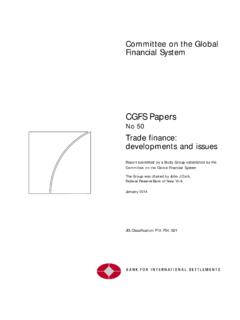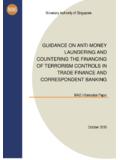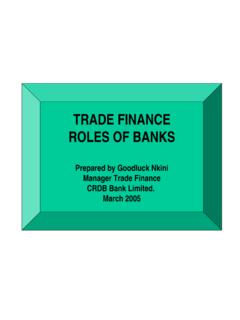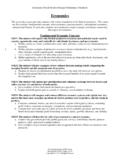Transcription of Basel Committee on Banking Supervision
1 Basel Committee on Banking Supervision Treatment of trade finance under the Basel capital framework October 2011 This standard has been integrated into the consolidated Basel Framework: Copies of publications are available from: Bank for International Settlements Communications CH-4002 Basel , Switzerland E-mail: Fax: +41 61 280 9100 and +41 61 280 8100 This publication is available on the BIS website ( ). Bank for International Settlements 2011. All rights reserved.
2 Brief excerpts may be reproduced or translated provided the source is stated. ISBN print: 92-9131-890-6 ISBN web: 92-9197-890-6 Treatment of trade finance under the Basel capital framework Contents Executive Introduction ..1 Committee s considerations regarding the issues raised ..2 Leverage ratio ..2 20% credit conversion factor under the risk-based measure ..3 One-year maturity Claims on banks ..4 Treatment of trade finance under the Basel capital framework Executive Summary Following consultations with the World Bank, the World trade Organisation and the International Chamber of Commerce, the Basel Committee on Banking Supervision has evaluated the impact of Basel II and III on trade finance in the context of low income countries.
3 As a result of this evaluation, the Committee has adopted two changes to the treatment of trade finance in the Basel II and III capital adequacy framework. These changes respect the integrity of the capital framework and its broader financial stability objectives. The changes to the capital framework agreed by the Committee are as follows: 1. waive the one-year maturity floor for certain trade finance instruments under the advanced internal ratings-based approach (AIRB) for credit risk; and 2.
4 Waive the so-called sovereign floor for certain trade - finance related claims on banks using the standardised approach for credit risk. Under the current AIRB rules, capital requirements for credit exposures are subject to a minimum maturity requirement of one year while the average tenor of trade finance transactions is significantly less than one year. Waiving the one-year maturity floor for issued and for confirmed letters of credit instruments that are particularly relevant for low income countries when they import goods would reduce capital requirements for banks engaged in trade finance and which use the AIRB.
5 The other change agreed by the Committee is relevant for banks using the standardised approach for credit risk. When a bank confirms a letter of credit, it has an exposure to another bank (the bank that issues the letter of credit or the issuing bank ). In the case of a low income country which imports goods, the issuing bank is usually domiciled in the importer s country (ie the low income country) and typically does not have an external credit rating.
6 Under the regulatory capital framework, where the risk weights are based on the external ratings of bank counterparties, claims on an unrated bank are subject to a risk weighting of 50% or, in the case of short term claims, 20%. The risk weighting applied to this bank exposure cannot, however, be lower than the risk weighting of the sovereign in which the issuing bank is incorporated. In the case of low income countries, this is typically 100% (the so-called sovereign floor ).
7 Waiving this floor to allow the risk weighting to move below 100% will help reduce capital requirements for banks engaged in trade finance and thus foster the import of goods for low income countries. Introduction At its November 2010 Summit in Seoul, G20 Leaders decided to monitor and assess trade finance programs in support of developing countries, in particular their coverage and impact on LICs (ie Low Income Countries), and to evaluate the impact of regulatory regimes on trade finance .
8 The Committee announced in its 1 December 2010 press release that it will evaluate the impact of the regulatory regime on trade finance in the context of low income countries. To carry forward the work, the Committee established its trade finance Group with a mandate to assess the issue in consultation with interested constituencies and to Treatment of trade finance under the Basel capital framework 1 finalise the work prior to the November 2011 G20 Leaders Summit.
9 The mandate noted that the trade finance Group was to respect the integrity of core parts of the financial stability agenda already agreed by the G20. The trade finance Group has held consultations with representatives from the International Chamber of Commerce (ICC), the World Bank (WB), and the World trade Organisation (WTO). It met with these organisations in February 2011 and July 2011, during which it discussed the characteristics of trade finance products, the potential impact of Basel II and III on trade finance and possible ways to address the issue.
10 Committee s considerations regarding the issues raised Based on the work of the trade finance Group, the Committee s focus has been on confirmed letters of credit, the most typical form of bank-intermediated contingent trade finance products and commonly used in trade with low-income countries. While data is scarce on the relative importance of the different types of trade credit, rough estimates based on ICC data show that letters of credit represent approximately 20% of all trade finance instruments but are particularly important for low-income countries.










